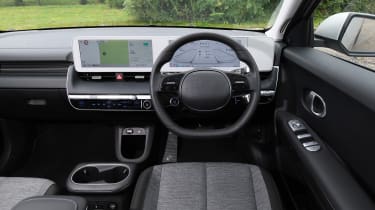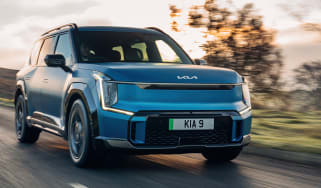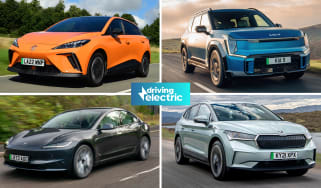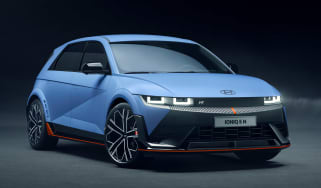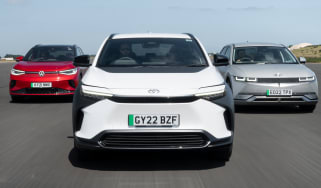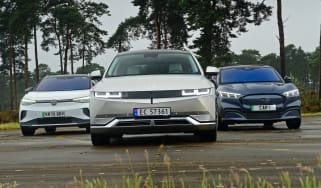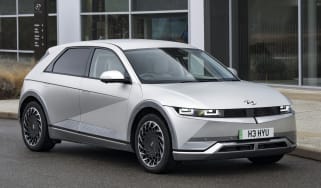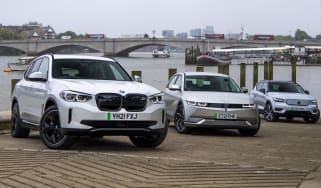Hyundai Ioniq 5 review
With more presence than most supercars, ultra-rapid charging and luxury-car-like ride quality and interior comfort, the Hyundai Ioniq 5 is hard to fault
Pros
- Looks
- Comfort
- Ultra-rapid charging
Cons
- No rear wiper
- Expensive top-spec versions
- Range compared to some rivals
|
Model |
Range |
Wallbox charge time |
Rapid charge time |
|
58kWh RWD |
240 miles |
9hrs 15mins (0-100%, 7.4kW) |
18mins (10-80%, 175kW) |
|
77kWh RWD |
315 miles |
11hrs 45mins (0-100%, 7.4kW) |
18mins (10-80%, 220kW) |
|
77kWh AWD |
298 miles |
11hrs 45mins (0-100%, 7.4kW) |
18mins (10-80%, 220kW) |
Hyundai Ioniq 5 verdict
The Hyundai Ioniq 5 is an outstanding electric car that has as much substance as style. Behind the sharp, modern looks is the very latest technology, both in terms of infotainment and charging. The Ioniq 5 is also impressively practical, beautifully finished and competitively priced, able to take on (and beat) rival offerings from Nissan and Toyota, all the way up to premium brands like BMW and Tesla.
It doesn’t offer the longest official range we’ve seen, but the Ioniq 5 has proven itself to be supremely efficient, not to mention comfortable and refined, making it a great long-distance cruiser as well as an exceptional family car.
Range details, specs and alternatives
While Hyundai’s budget-minded Ioniq Electric hatchback and Kona Electric SUV offered the likes of the MG ZS EV, Kia Niro EV (formerly e-Niro) and Nissan Leaf stern competition, the Ioniq 5 has far loftier ambitions. The electric family hatchback was the first in a new generation of zero-emission models from Hyundai, paving the way for the Ioniq 6 saloon that launched earlier this year and Ioniq 7 seven-seat SUV which is due to arrive in the next few years.
As we said, this is technically a hatchback, though a very large one. It’s not an SUV, despite how it may appear in pictures, but its sea of potential rivals includes the very best electric family cars around, the majority of which are indeed SUVs. The top contenders are the Audi Q4 e-tron, Nissan Ariya, Toyota bZ4X, Volkswagen ID.4 and even the Tesla Model Y and upcoming Ford Explorer.
It’s based on the same E-GMP underpinnings used by the Kia EV6 and Genesis GV60, cars that the Ioniq 5 also competes against. There's a choice of two battery sizes, as well as rear or four-wheel drive, so you should be able to find the right mix of performance and range you're looking for. That being said, Hyundai is also working on an Ioniq 5 N hot hatch to expand the options further.
Hyundai no longer offers the entry-level SE Connect trim for the Ioniq 5, leaving Premium, Ultimate and the range-topping Namsan Edition. Standard kit is very generous with 19-inch alloy wheels, LED headlights, parking sensors and smart cruise control all included, while inside every model features a wireless smartphone charging pad, heated seats, 64-colour ambient lighting and two 12.3-inch displays running Hyundai’s latest infotainment system, plus Android Auto and Apple CarPlay connectivity.
While the base Premium trim is available with both the 58kWh and 77kWh battery packs, Ultimate and Namsan Edition cars are only available with the bigger battery, leading to a substantial £6,500 price difference over and above the Premium model. Alongside the larger battery, Ultimate trim nets you larger wheels, a sliding centre console, ventilated front seats, a head-up display and full leather upholstery. Namsan Edition adds ‘virtual’ door mirror cameras and a large panoramic sunroof, but neither is worth spending extra money on over the regular Premium car.
Every new Ioniq 5 also comes with pre-conditioning and battery heating functions that manage battery temperature while on the move and help to improve real-world charging performance. Other helpful extras include a heat pump to improve efficiency in colder weather and vehicle-to-load (V2L) charging that allows you to power portable devices, camping kit or even charge another EV using the Ioniq 5’s battery.

Make sure to check out our triple test between the Hyundai Ioniq 5, Toyota bZ4X and Volkswagen ID.4, or for a more detailed look at the Hyundai Ioniq 5, read on for the rest of our in-depth review…

